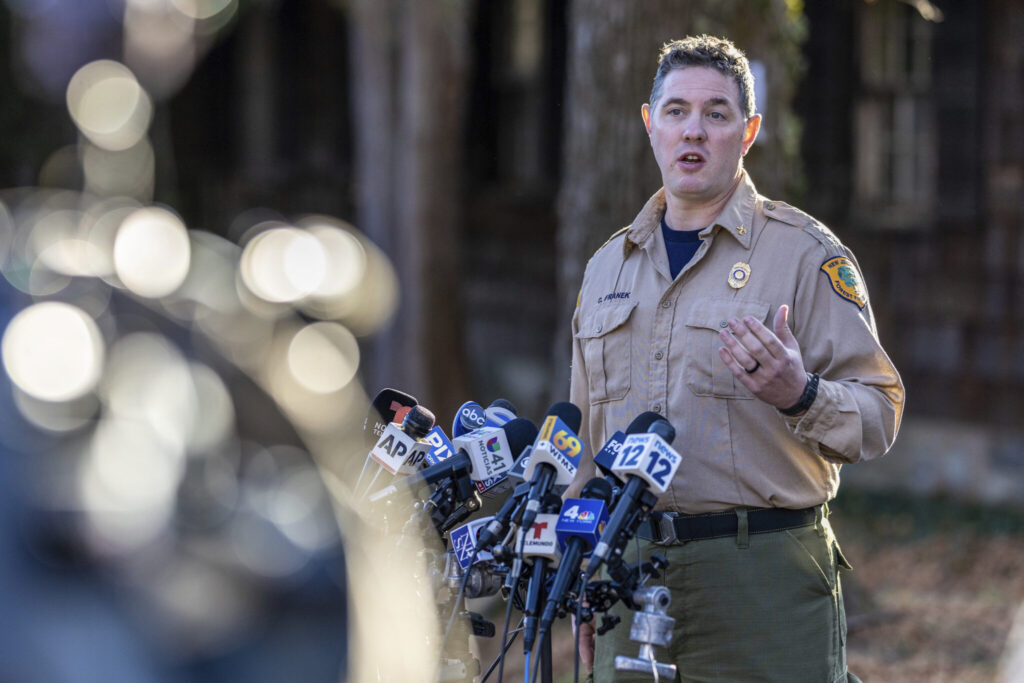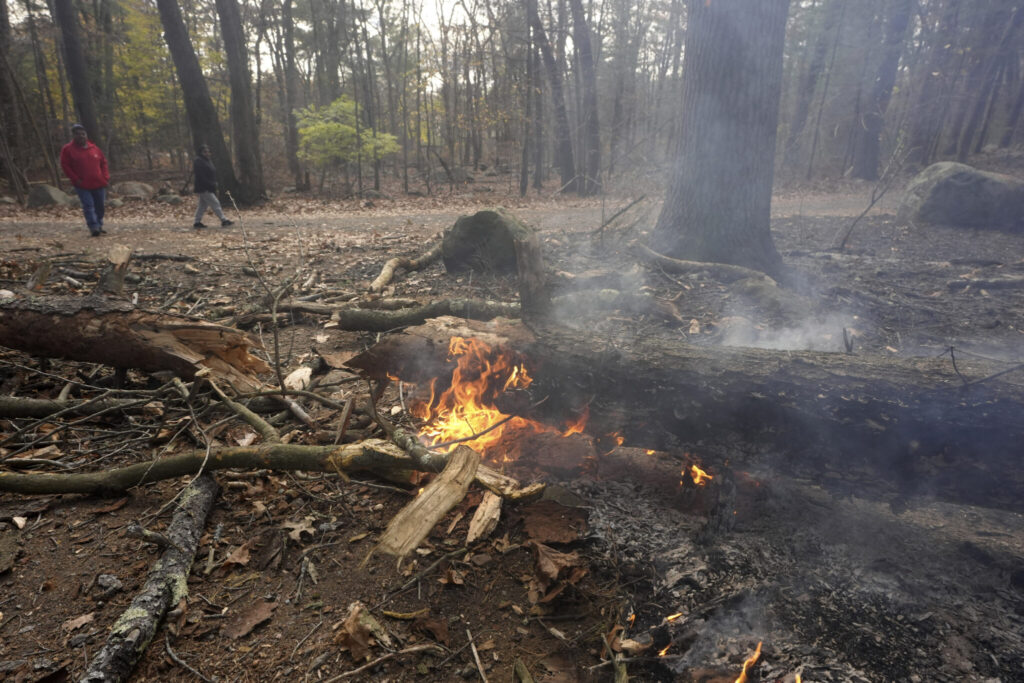U.S. wildfires/ New Jersey fire/ California Mountain Fire/ Ventura County wildfire/ wildfire containment/ Newslooks/ RINGWOOD/ N.J./ J. Mansour/ Morning Edition/ Firefighters are battling wildfires on both U.S. coasts, with large fires in California and smaller blazes in the Northeast. California’s Mountain Fire has led to evacuations, while multiple fires in New Jersey and Massachusetts have disrupted local activities, worsened air quality, and required intensive containment efforts amid dry conditions.

Wildfires Across U.S. Coasts: Quick Looks
- East Coast Fires: Northeast wildfires impact New Jersey, New York, and Massachusetts communities.
- West Coast Wildfires: California’s Mountain Fire in Ventura County prompts thousands of evacuations.
- Tragic Fatality: A New York parks employee died while assisting fire crews.
- Health Warnings: Air quality advisories issued in parts of the Northeast due to smoke.
- Dry Conditions: Persistent drought fuels wildfires and hampers containment.
Deep Look
Fire crews across the United States are facing challenging conditions as they battle active wildfires on both coasts. In the Northeast, small but intense fires are burning through parts of New Jersey, New York, and Massachusetts, worsened by unusually dry autumn weather. Meanwhile, on the West Coast, California firefighters continue to make headway on the large Mountain Fire in Ventura County, where strong Santa Ana winds have contributed to the blaze’s rapid spread.
Wildfires in the Northeast
Firefighters in New Jersey and New York are working tirelessly to contain the Jennings Creek Wildfire, a 4.7-square-mile blaze that ignited along the border between the two states. Rainfall of about a quarter-inch overnight from Sunday into Monday offered some relief but was not enough to halt the fires entirely. The Jennings Creek fire is one of several blazes that have ignited in New Jersey and neighboring states, fueled by the region’s prolonged dry conditions.
Officials say a lack of substantial rain since September has left the area’s vegetation vulnerable. Forest floors are blanketed with dry leaves that mask fire hazards beneath. “Beneath the surface leaf litter that falls off the trees, that stuff is bone dry,” noted Bryan Gallagher, a forest ranger with the New York State Department of Environmental Conservation. He explained that despite light rain, fire can smolder in the ground cover, only to flare up again in the right conditions.
In Ringwood, New Jersey, local air quality has been impacted, with authorities issuing advisories over the weekend due to heavy smoke drifting from the fires. Dana Van Allen, a resident of Ringwood, described waking up to the smell of smoke and finding ash on her deck. “It was very stifling. We were very scared,” she shared.
The fires have also affected local events, with a Veterans Day ceremony in West Milford, New Jersey, postponed. Many of the firefighters in the region are veterans, and local Veterans of Foreign Wars commander Rudy Hass urged residents to keep the firefighters in their thoughts.
Firefighter Fatality and Health Concerns
Tragically, an 18-year-old New York State Parks employee, Dariel Vasquez, lost his life over the weekend while assisting fire crews in the Greenwood Lake area. He died after being struck by a falling tree. New York State Police are investigating the incident as Vasquez’s death highlights the dangers that responders face amid worsening fire conditions.
The fires in the Northeast have also led to air quality concerns, with health advisories issued across New York and northeastern New Jersey. While the recent rainfall and wind shifts helped clear the air slightly, officials remain cautious as dry conditions persist in the region.
In Massachusetts, the Lynn Woods Reservation, located about 10 miles north of Boston, has also been hit by wildfires. The Lynn Fire Department reported that the fires, fueled by dry leaves and gusty winds, have burned around 400 acres. Lynn Fire Chief Dan Sullivan stated that the main fire roads have helped contain the blaze, although the department remains on alert to prevent further spread.
West Coast Wildfires: California’s Mountain Fire
In California, firefighters are working to contain the massive Mountain Fire in Ventura County. The blaze, which started Wednesday, has grown to roughly 32 square miles, forcing thousands of residents to evacuate and destroying at least 192 structures. By Monday, containment was at 41%, but warm, dry Santa Ana winds have continued to fuel the fire, complicating efforts.
The cause of the Mountain Fire remains under investigation. Local authorities are working with residents to ensure safe evacuations and to manage the fire’s impact on communities. Officials report significant property loss, particularly among homes, and more structures remain at risk.
New Evacuations in Nevada
In neighboring Nevada, high winds spurred the spread of a new wildfire near Reno, resulting in mandatory evacuations for hundreds of homes. Officials closed the main highway to Lake Tahoe as the fire spread rapidly through mountain vegetation. Adam Mayberry, spokesperson for the Truckee Meadows Fire Protection District, stated that around 3,000 residents were ordered to evacuate. Crews from various agencies, including federal responders, arrived to combat the blaze as rain began to fall.
Persistent Dry Conditions Across the U.S.
The Northeast and West Coast have both experienced prolonged dry spells, a significant contributor to the wildfire threat. In New Jersey, the state Department of Environmental Protection has scheduled a hearing to discuss current water supply conditions, as the last measurable rainfall occurred on September 28. State officials are closely monitoring water resources amid forecasts predicting continued dry weather.
The recent dry conditions have left forests and natural areas more susceptible to fires, with fallen leaves adding an extra layer of fuel. A National Guard helicopter, capable of dropping 350 gallons of water at a time, has been deployed in New Jersey, while two Black Hawk helicopters are assisting with water drops in New York. This air support, combined with ground crews, aims to contain the fires before they can spread further.
In the Lynn Woods Reservation of Massachusetts, firefighters have leveraged fire roads to contain the flames. However, Chief Sullivan of the Lynn Fire Department noted that the dry conditions are unprecedented for this time of year, a sentiment echoed by officials across the region.
Looking Ahead
As dry weather and persistent winds continue to fuel wildfires on both U.S. coasts, firefighters are prepared for a prolonged effort to bring the blazes under control. With communities affected by air quality issues, property loss, and event disruptions, officials emphasize the need for ongoing precautions. Residents in fire-prone areas are urged to remain vigilant, monitor local advisories, and prepare for potential evacuations.
The current conditions have brought renewed attention to fire prevention and the importance of resource management, particularly as climate patterns suggest that dry spells may become more frequent in traditionally wet seasons. In the meantime, fire crews on both coasts are focused on containing active fires and protecting communities from further harm.







You must Register or Login to post a comment.